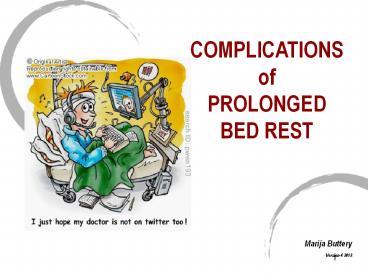Across%20the%20lifespan - PowerPoint PPT Presentation
Title:
Across%20the%20lifespan
Description:
Title: Across the lifespan Author: Annette Last modified by: Richard Buttery Created Date: 6/8/2006 4:14:25 AM Document presentation format: On-screen Show – PowerPoint PPT presentation
Number of Views:114
Avg rating:3.0/5.0
Title: Across%20the%20lifespan
1
COMPLICATIONS of PROLONGED BED REST
Marija Buttery Version 4 2012
2
Pressure Area Care (PAC)
- What are pressure ulcers?
- What are pressure sores?
- What are decubitis ulcers?
- What causes them?
- How do we prevent them?
3
Pressure Ulcers
- Any lesion caused by unrelieved pressure
resulting in damage of underlying tissue (AHCPR
1994) - Pressure ulcers can occur anywhere on the body
- Pressure Ulcers, Pressure Sores and Decubitis
Ulcers are all the same thing
4
Pressure ulcer staging
- Stage I Persistent redness
- Stage II Partial thickness skin loss
- Stage III Full thickness skin loss
- (subcutaneous)
- Stage IV Full thickness loss (to fascia)
5
Pressure Area Care
- One of the vital roles of the nurse after
assessment is to prevent damage/illness. - There are a variety of patients who we assess and
determine as being at increased risk of
developing pressure sores. - Implementation of Norton Risk Assessment scale,
Braden Scale, Gosnell Scale (and possibly others)
is meant to reduce development of new pressure
ulcers in high risk patients
6
Pressure ulcer causes
- Prolonged pressure
- Duration and intensity
- Location
- Extended pressure that blocks flow to the tissue
between the source of pressure and the bone - Shear
- Friction
7
Pressure ulcer etiology
- Pressure exerted by bony prominences on the body
that stop capillary flow to the tissues. - Deprives tissues of oxygen and nutrients causing
cell death. - Pressure greater than 32mmHg exerted by bony
prominences disrupts blood flow.
8
Pressure ulcer etiology
- Function of both time and pressure
- 70mmHg pressure for two hours produces
irreversible injury - greater pressure takes less time
- lower pressure takes more time
- obese may be much lower emaciated may be much
higher risk - TURNING SCHEDULES MUST BE INDIVIDUALISED!!!!
9
Pressure Prevention
- The main prevention of these ulcers is to stop
the damage before it starts. This includes all
three causes - pressure
- friction
- shearing
- Management also includes assessment, monitoring
and evaluation of the person as a whole and
improving aspects such as - nutrition
- fluid balance
- skin integrity
- movement/mobility
- underlying health conditions
- cognitive function
10
Pressure Causing Things
- Class discussion
- Sheets and blankets
- Monitors
- Tubing (oxygen, drips and drains etc.)
- Clothing (including nappies)
11
WHERE ARE THE POTENTIAL PRESSURE POINTS?
- Positions
- Supine
- Prone
- Lateral
- Orthopnoeic
12
MOBILITY
- To care for clients who have limited mobility,
the nurse needs to understand the physical and
psychological effects of immobility, the
complications these may lead to and nursing
interventions that can prevent these
complications. - One of the nurses roles is to encourage mobility,
whether that be passive or active.
13
MOBILITY
- The provision of various devices may help the
client to be more independent. It may also
assist the nurse in not having to use as much of
their own physical force to ambulate the patient. - Assessment of the patients mobility should be
assessed each time they require assistance,
whether that be in bed or out. - This constant update of information allows for
the nurse to better protect themselves against
injury and be in a better position to provide the
most appropriate assistance to their client.
14
USE OF MOBILITY AIDS
- Ensure the equipment is in working condition
- Adjust the aid to the correct height for the
individual - Ensure the patient knows how to use the walking
aid correctly - Maintain a safe environment
- Evaluation
15
MOBILITY AND EXERCISE
- The musculoskeletal, nervous and cardiovascular
systems combine to allow for movement. - Exercise can be active or passive.
- Active exercise involves voluntary effort.
- Passive exercise is movement by another
individual.
16
Why Exercise?
- Stimulation
- Promote circulation
- Muscle tone and strength
- Joint mobility
- Relaxation - can promote sleep
- Combat boredom
- Combat stress
17
Complications Of Decreased Mobility and Bed Rest
- Pressure on bony prominences decubitis ulcers
- Decreased use of muscles and joints muscle
wasting and contractures - Venous stasis Deep Vein Thrombosis (DVT)
- Pulmonary Stasis lung congestion
- Urinary Stasis infection or calculi
- Decreased intestinal peristalsis constipation
- Decreased vasomotor tone hypotension
- Decreased independence depression, boredom,
anxiety - Foot drop
18
Thrombosis
- Some people are at greater risk of a DVT forming
than others - If a DVT does form it needs to be treated quickly
to prevent the clot from breaking , travelling
around the body causing greater damage such as - Cerebrovascular Accident (CVA)
- Myocardial Infarction (MI)
- Pulmonary Embolis (PE)
- Treatment includes restricting mobility,
medication to reduce blood clotting, and treating
the symptoms
19
Sequential Compression Devices (SCD) - also known
as calf stimulators, for prevention of
DVT.Should be used in conjunction with
anti-embolic stockings
Sequential Calf Compression
20
Relief of Pressure On Feet
- Pleat in the sheets/blankets
- Bed Cradle - reduces the pressure on the top of
the feet for pain relief or the prevention of
foot drop (another complication of prolonged bed
rest)
21
The LungsPooling of secretions in the lungs
from prolonged bed rest and lack of movement can
lead to lung damage and pneumonia. Deep
breathing and huffing exercises are needed to
expand the lungs and expectorate the secretions
22
The KidneysPooling of urine in the urinary
bladder from lying in one position increases the
risks of urinary tract infections
23
Any Questions?































